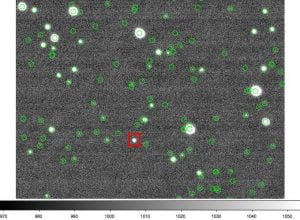
This image was captured with the Zadko telescope during the event. The green squares are known sources and red square shows the bright “unknown” source responsible for the Gamma Ray Burst. Credit: David Coward.
Just 215 seconds after receiving an alert from a NASA satellite and with no direct human involvement, the Zadko telescope was the first in the world to turn its gaze to the light coming from a powerful explosion billions of light years away.
Located near Gingin, the Zadko Telescope is an important facility for astronomy research at The University of Western Australia (UWA), and is a joint resource for the International Centre for Radio Astronomy Research (ICRAR) and the Australian International Gravitational Research Centre (AIGRC).
At 7.05 pm on Sunday 24 October, the Zadko received a signal from the NASA’s “Swift” satellite indicating that something exciting was happening in the WA night sky. Without a moment to lose, the unmanned telescope responded to the call to action by repositioning itself so that its giant one metre mirror could capture the light coming from what scientists call a gamma ray burst.
Gamma-ray bursts are the most powerful explosions in the Universe since the Big Bang. They are brief, intense flashes of gamma radiation coming from other galaxies in the very distant Universe. So far scientists don’t know exactly what causes them, but some suggest they signal the birth of a black hole in a massive stellar explosion, colliding neutron stars or some other exotic phenomenon.
The image below was captured with the Zadko telescope during the event. The green circles are known sources and the red square shows the bright “unknown” source at the location of the burst.
Co-Director and Zadko Systems Manager Dr Myrtille Laas-Bourez designed the software that allows the Zadko to operate autonomously and respond to events such as this.
“This was a really bright gamma ray burst event and Zadko was the first ground- based telescope to catch it,” Dr Laas-Bourez said. “This is very exciting because it shows the robotic system is working well and is capable of doing some really interesting science.”
The telescope was made possible by a philanthropic donation by businessman James Zadko to the University. The instrument is a resource for research, training, and science education. It is co-located with a science and astronomy outreach facility, and with the Australian International Gravitational Observatory (AIGO).

